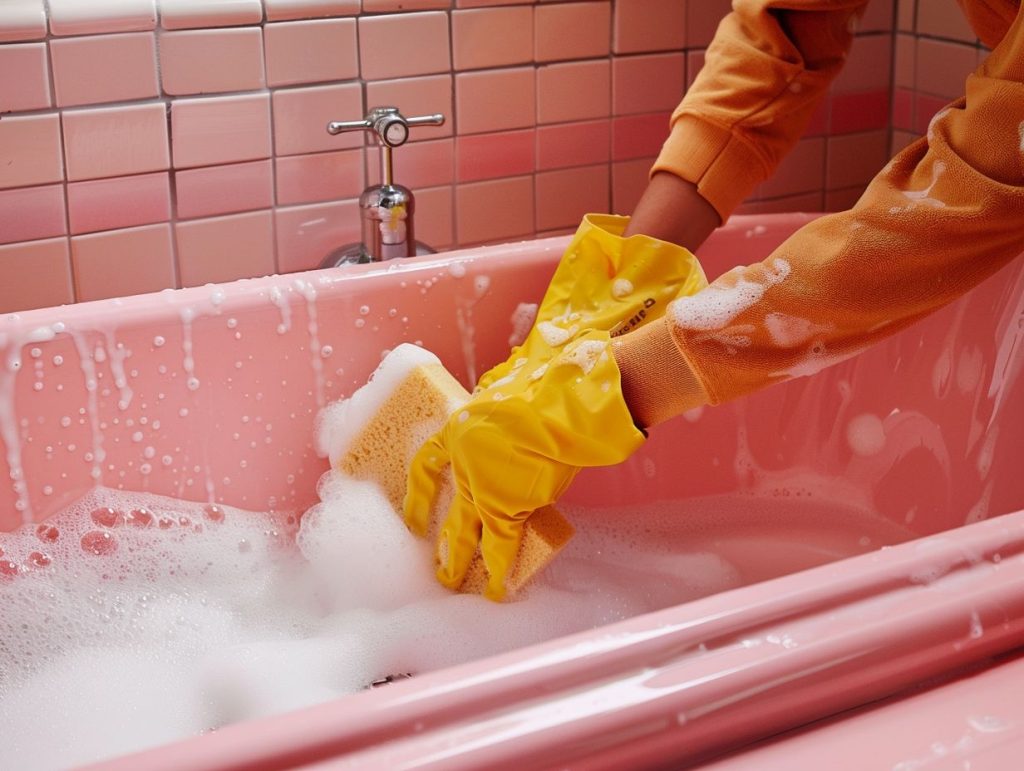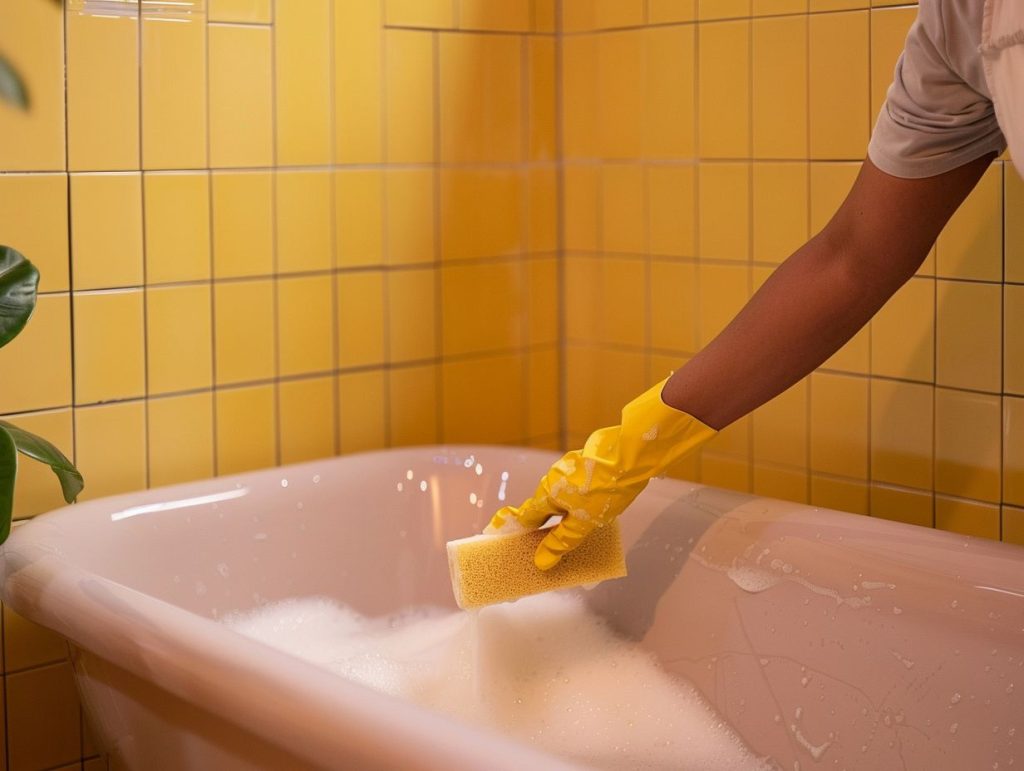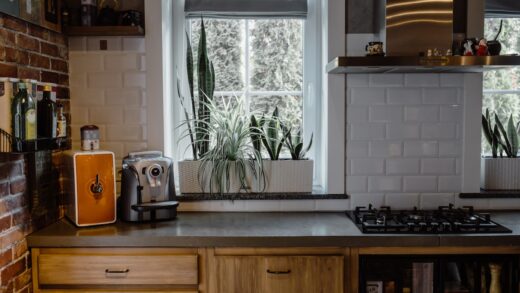Ready to learn how to keep your bathtub shining bright without relying on harsh chemicals? It’s high time I told you more about bathtub cleaning, reviewed typical household cleaners and some natural options for the job, walked you through the steps of scrubbing your tub, gave you pointers on how to keep it clean and spill the tea on how to tackle those stubborn stains and buildup.
The Importance of a Clean Bathtub
Keeping your bath clean is essential, not just for hygiene but also for the overall feel of your bathroom. A neat bath enhances your bathing experience and promotes a healthier home environment. It’s surprising how something as simple as regularly cleaning your bath can significantly impact your daily routine.
By keeping your bath clean, you’re ensuring a relaxing bath time and preventing the buildup of unpleasant grime and mould that can affect your health. A shining bath adds a lovely touch to your bathroom, making it look more welcoming.
Adopting cleanliness in your living spaces can ultimately enhance your overall well-being and elevate your home environment to the next level.

Benefits of Regular Cleaning
Regular bath cleaning is key to keeping it sparkling clean and free from grime, stains, and soap residue. It’s a simple and eco-friendly way to maintain a fresh and inviting bathroom space. Establishing a routine for bath maintenance allows you to address any issues before they become stubborn problems. Natural remedies like vinegar and bicarbonate of soda are gentle but effective at removing tough stains without harsh chemicals.
A clean bath not only ensures a hygienic environment but also enhances the overall look of your home. Keeping your bath clean and well-maintained creates a relaxing and rejuvenating atmosphere during your daily self-care routine.
Common Household Products for Bathtub Cleaning
When cleaning your bath, you don’t have to reach for those heavy-duty detergents. Instead of relying on harsh chemicals, think about using common household items to achieve a sparkling clean bath. For instance, vinegar acts as a natural disinfectant, cutting through grime and leaving surfaces gleaming. Bicarbonate of soda is another fantastic option; it’s a gentle abrasive that helps scrub away stubborn stains without scratching your tiles or tub. You can also explore eco-friendly cleaning products that are both effective and safe for the environment. By choosing these everyday items, you’ll not only maintain a clean and shiny bath but also contribute to a healthier home.
These natural alternatives aren’t just good for keeping your bath spotless and creating a safer environment for you and your loved ones. Vinegar is excellent at cutting through soap scum and mineral deposits, leaving your bath looking brand new. On the other hand, bicarbonate of soda is a gentle abrasive that helps tackle stubborn stains and grime. Mixing these two gives you a powerful yet safe cleaning solution.
Sprinkle some bicarbonate of soda, spray some vinegar, let it fizz up, and scrub away for a squeaky-clean bath. This method is effective, easy on the wallet, and eco-friendly.
Effective Natural Alternatives to Heavy Detergents
When cleaning your bath, opt for natural and eco-friendly solutions for a safe and effective way to tackle grime and stains. DIY mixtures with vinegar, bicarbonate of soda, and gentle scrubbing techniques can leave your bath sparkling clean.
Not only are these DIY solutions cost-effective, but they also help reduce the carbon footprint of traditional cleaning products. By incorporating ingredients like vinegar and bicarbonate of soda into your cleaning routine, you can easily remove soap scum and mineral deposits without harming the environment.
Using non-toxic solutions also creates a healthier living environment for you and your family, benefiting both your home and the planet. It’s a win-win situation for everyone involved.

Step-by-Step Guide to Cleaning Your Bathtub
Cleaning your bath doesn’t have to be a daunting task. You can effectively remove dirt, grime, and stains with the proper technique and cleaning solutions, leaving your tub sparkling and fresh.
Start by gathering your cleaning supplies, such as a non-abrasive cleaner, a scrubbing sponge, bicarbonate of soda, vinegar, and a microfibre cloth. Fill a spray bottle with equal water and white vinegar for an effective homemade cleaner. Spray the solution generously on the surfaces of your bath and let it sit for a few minutes to loosen stubborn grime. Use the scrubbing sponge to scrub away any dirt, paying extra attention to areas with soap scum buildup. Rinse the bath thoroughly with water and wipe it dry with a microfibre cloth for a shiny finish.
To maintain this cleanliness, make it a habit to clean your bath weekly or fortnightly, depending on usage, to prevent grime and stains from accumulating again.
Preparation and Supplies
Before cleaning the bath, ensure you have all the necessary supplies, like gloves, sponges, and protective gear. This will ensure your cleaning experience is safe and effective.
Take out any items from the bath to easily access all surfaces. Removing personal items from the bath helps with thorough cleaning and lowers the risk of accidental damage.
It’s also a good idea to clear up the space around the bath so you can easily reach all the areas that need cleaning. By decluttering the area, you set yourself up for a smooth and efficient cleaning job.
Fill a bucket with warm water and your favourite cleaning solution to soak your sponge or cloth and effectively scrub the bath surface.
Cleaning Techniques for Different Types of Bathtubs
Cleaning different types of bathtubs requires specific techniques that match the material and surface. Knowing the right methods for your bathtub type is key to effectively getting rid of stains, grime, and buildup.
If you have an acrylic bathtub, avoid abrasive cleaners. Instead, go for gentle, non-abrasive solutions to avoid scratching. A mix of warm water and dish soap can do wonders in removing dirt and grime from an acrylic surface. Conversely, fibreglass tubs can lose their lustre if exposed to harsh chemicals. Stick to a mild cleaner or a baking soda and water paste for a safe cleaning option.
Cast iron tubs thrive with a pH-neutral cleaner to keep their enamel finish intact. For porcelain tubs, a baking soda paste is your go-to solution for tackling stubborn stains.
Tips for Maintaining a Clean Bathtub
In terms of keeping your bath clean, it’s more than just a quick scrub now and then. You’ve got to take some preventive steps to steer clear of mould, mildew, and that yucky soap residue buildup. Plus, adding some essential oils can make your bath time extra special while also helping to keep things spick and span.
One clever move is to make sure your bathroom has good ventilation. That way, you can reduce moisture that likes to hang around and invite mould and mildew to the party. And after you’re done with your bath, give the tub a good rinse and wipe it down to stop soap scum from setting up camp.
For tougher grime situations, mix up some bicarbonate of soda and vinegar and give your bath a good scrub. It’ll help to bust through any stuck-on gunk. To keep that fresh scent going strong, drop a bit of your favourite essential oil onto a cloth or cotton ball. Pop it near the bath, leaving you with a lovely natural fragrance that’ll make your whole bathroom feel cosy and inviting.
Preventive Measures and Maintenance Schedule
Establishing a maintenance schedule for your bath can help prevent the buildup of grime, soap residue, and mould. Regular upkeep of grout, sealant, and surfaces ensures the freshness and cleanliness of your bath for an extended period.
By incorporating preventive measures into your routine, such as wiping down the bath after each use with a gentle cleaner to remove soap scum and prevent mould growth, you can maintain a pristine bath environment.
Paying attention to commonly overlooked areas, such as grout lines and corners, where dirt tends to accumulate, will help prolong the overall cleanliness of your bath.
Regularly inspecting and resealing any worn-out sealant will prevent water seepage and mould formation, ensuring a clean and hygienic bathing space.
Dealing with Stubborn Stains and Buildup
When you’re dealing with stubborn stains and buildup in your bath, it can feel like a real challenge to get rid of them. But fear not—there are natural products and organic cleaners out there that can come to your rescue. Tackling issues like limescale and watermarks with eco-friendly alternatives is the way to go if you want to bring back that shine and cleanliness to your tub.
You can work wonders with ingredients like vinegar, bicarbonate of soda, and lemon juice when breaking down those tough stains and limescale. Whip a paste using bicarbonate of soda and water to scrub away grime, or mix vinegar with water to take on those pesky watermarks. For a fresh scent and an extra cleaning boost, squeeze some lemon juice onto the areas that need extra love. These natural remedies aren’t just effective at getting rid of stubborn stains but also help create a healthier environment by cutting back on harsh chemicals.
Natural Solutions for Tough Cleaning Challenges
Natural solutions can be your best mate when dealing with tough cleaning challenges in your bath. They require a bit of elbow grease but can work wonders on issues like limescale and watermarks. Homemade remedies give you a chemical-free and eco-friendly way to keep your bath sparkling.
Take, for example, a simple mix of bicarbonate of soda and vinegar. It’s like magic for those stubborn limescale deposits. Just sprinkle bicarbonate of soda generously over the problematic areas, then spray on a mixture of vinegar and water. Watch it fizz! Let it sit for a few minutes, then grab a brush or sponge and scrub away. This method not only tackles limescale but also helps to get rid of watermarks, leaving your bath looking shiny and new.
If you want to liven things up, adding a few drops of essential oils like tea tree or lemon can give your homemade cleaner a pleasant fragrance while boosting its cleaning power.


Recent Comments